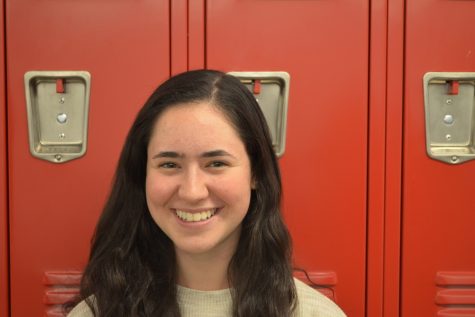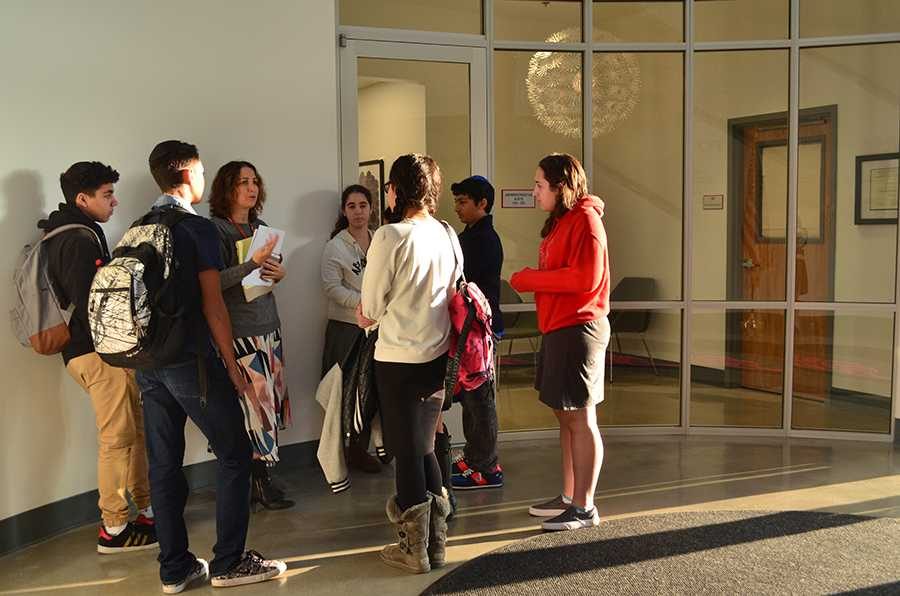Applicants increase in number, but grade cap to stay at 60
BP Photo by Michelle Hirschhorn
GREETING: Director of Admissions Natalie Weiss introduces prospective students to freshman Student Ambassadors.
In spite of a record 115-plus applicants for next year’s freshman class, the administration has decided to keep enrollment capped at 240 students — roughly 60 students per grade.
The maximum class size was set based on educational, philosophical and financial considerations, Rabbi Segal told the Boiling Point, which don’t change just because the applicant pool grows.
“If the school gets beyond this number of students, we lose that sense of community that makes the school special, “ Rabbi Segal said.
“It’s hard from a decision making perspective and it’s hard emotionally, but if the school were bigger, it wouldn’t be Shalhevet.”
Last year there were 90 applicants, of whom 65 were initially offered spots, but 71 were eventually accepted. This is because not all of those accepted enrolled, so some were admitted from a waitlist. One who was told the Boiling Point that she understands the need for the list.
“I know that they want diversity and that there is a certain limit of students,” said freshman Abby Blumofe. “I was upset about not getting in at first, but once I got in I was so happy.”
Applications have been building steadily since 2010, when the administration was thrilled to receive 38 applicants, according to Admissions Director Natalie Weiss, who started that year. Two years ago, this number was around 60, and has been increasing every year, she said.
Among the reasons for this growth, Ms. Weiss said in an interview, are the various new ways in which Shalhevet is reaching out to the broader community. She mentioned the recent Steve Glouberman tournament and Shalhevet Institute events as examples.
Ms. Weiss has also created Winterm, a program in which 7th- and 8th- grade prospective students can try out certain Shalhevet co-curriculars for three consecutive Sundays.
Other events include prospective parent “parlor meetings” with Shalhevet teachers and administrators – at least one for each feeder school – along with student tours, which occur weekly on Tuesday, and the Open House school showcase, which this year was five hours long so people could attend at various times .
Ms. Weiss has also worked to build relationships with feeder schools, inviting principals on tours and visiting schools herself, sometimes with other Shalhevet administrators.
In addition to the main feeder schools Maimonides, Hillel, and Pressman, this year Shalhevet has received more applications from both Emek Academy and Sinai-Akiba.
Ms. Weiss said 11.2 percent of this year’s applicants are from Emek, almost double than last year’s 5.7 percent. Last year there were no Sinai applicants, but this year 7.7 percent of the applicants are from Sinai. She declined to give exact exact numbers.
“These are relationships we have been nurturing and it’s nice to see the positive results this year,” she said.
Other feeder schools include Yavneh, Ohr HaChaim, Kadima, Kabbalah and some public schools. In the past, Shalhevet has received applications from Milken, though none came from Milken this year.
Rabbi Segal said the growth in applications makes the decision-making process harder.
“It’s clear that there will be students who won’t get in that could succeed here,” he said. “When you’re choosing between two important values, you have to pick the one that preserves the nature of the enterprise. That’s the number one goal- keeping Shalhevet how it is.”
Flexibility is limited because it’s not feasible to add just a couple more kids per grade, Rabbi Segal explained. The grades now each have three 20-student sections — or three classes going on at once — and a few more would mean adding a whole new section, meaning four classes per grade instead of three.
At 20 per grade, that would eventually mean adding 80 more students to the school, taking maximum enrollment from 240 to 320.
“We don’t want any kid to be anonymous,” said Ms. Weiss.
A prospective student from Maimonides told the Boiling Point that he is not sure if he will get in because of the increasing demand for the school.
“There are a lot of kids applying and there’s not a lot of spots to fill,” said Maimonides eighth-grader Hayden Klein.
There are many criteria for who is accepted into Shalhevet, but Rabbi Segal and Ms. Weiss both said that the number one factor the admissions committee considers is menchlichkeit – being a good, kind and respectful person.
There also has to be a sense that the student will be a good fit for the school and that the family and student know the school’s atmosphere, values and goals. Having siblings in the school is a consideration but doesn’t make for automatic acceptance, Ms. Weiss said.
The committee also looks at whether Shalhevet can meet the student’s academic needs – whether that be with challenging enough courses or Student Support.
Shalhevet doesn’t recruit for any specific type of talent, Ms. Weiss said, but this year’s application asked whether the students wanted to share anything extra about themselves, such as hobbies or other pursuits outside school. Since Shalhevet is a Modern Orthodox school, it is important that applicants are passionate about Judaism, she said.
The committee also seeks diversity, which comes naturally in terms of how people think about things, said Ms. Weiss, and what their family structures are like.
Finances are also a consideration. A grant providing scholarships from the Jim Joseph Foundation has expired, but Rabbi Segal said the total amount of money given in financial aid is staying the same.
The Jim Joseph grant helped Shalhevet build an endowment, so now Shalhevet is taking the money being earned on that endowment and giving that to awardees.
In addition to the eighth-grade applicants, Natalie said there are five or six transfer applicants from a variety of schools. She said most of them were offered spots as freshmen, declined them, and are now asking to come back.
The rate of Shalhevet students transferring to other schools has remained constant for the past two to three years at zero to two students leaving per year, Natalie said.
Notification letters will be emailed out Feb 17.
Despite the growing number of applicants, Natalie said she still feels it was important to have multiple admissions events.
“You can never get complacent,” Natalie said. “You can’t say because we have a waiting list, we’re going to have one next year and we’re always going to have one. With every new group of prospective students parents, we have treat them to the same opportunities to get to know Shalhevet.”

Ma’ayan Waldman has interviewed, reported, and reviewed for the Boiling Point since ninth grade. She has served as staff writer, Arts Editor and Opinion Editor, Community Editor during her junior year, and is now co-Editor-in-Chief. Aside from her passion for journalism, she also enjoys debate, Mock Trial, and swimming. Outside of school, she loves spending time with her family and friends and listening to music.








